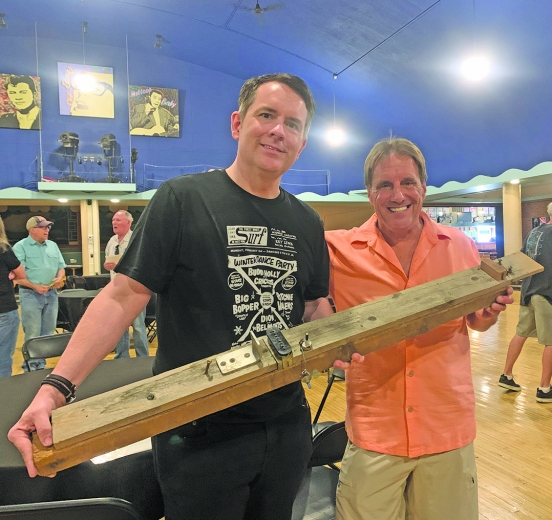Surf Ballroom receives historic Les Paul artifacts to add to their collection

Surf Ballroom CEO Brian Luallen and Jim Wyoscki with one of Les Paul’s solid body electric guitar prototypes donated to the Surf. - Reporter photo by Jenna Prather
By:
Jenna Prather
Editor
At the presentation of “Les Paul - From Start to Finish,” presenter Jim Wysocki gifted the Surf Ballroom with multiple artifacts from his collection to add to their own. Items that have a significance to the history of Les Paul and of rock and roll itself.
The Surf Ballroom held “Les Paul - From Start to Finish” on Saturday, June 21, in its main ballroom. It was the inaugural Master Class for the Surf Ballroom Music Experience Center, a part of the Surf’s mission to bring more education opportunities to its audience.
This interactive program honored the groundbreaking contributions of Les Paul— a musician, inventor, and pioneer of modern sound. Widely recognized as one of the most influential figures in music history, Les Paul’s collaboration with Gibson led to the creation of the Gibson Les Paul guitar. His innovations in multitrack recording and solid-body electric guitar design forever changed the landscape of both live performance and studio recording.
The class was led by Wysocki, a long time friend of Les Paul.
Wysocki was recruited by Molly Kern, events coordinator for the Surf, who happened to sit down and start talking to him while on vacation.
“And we started talking about Les Paul, for some reason,” Wysocki said. “She went her way and we [Wysocki and his wife] went back to New Jersey. I got a call about a year ago from Molly. She said, ‘We have this place in Clear Lake, Iowa.’ My first thing is, where the hell is Clear Lake, Iowa? ‘And we have this place called the Surf Ballroom. They're doing a little history thing there,’ and it's because of Molly we're here.”
Molly is a teacher, so as a thank you, Wysocki presented Molly’s husband (Molly, herself, wasn’t able to make it to the event) with Les Paul’s pencil sharpener.
“I'm like, how fitting for a school teacher,” Wysocki said.
Wysocki is a former police officer and current mayor of Mahwah, New Jersey. He was a close friend and confidant to Les Paul until his death in 2009.
“I was at his house three times a week for 28 years. And every time I left his house, he gave me something, whether it be a guitar pick, a guitar,” Wysocki said.
And with his crew of Jack Wilson and driver Mike Rudolph, he brought many of the things of Les’ he had to the Surf for the presentation. Including what is considered the very first solid body electric guitar.
“His first guitar was a Sears Troubadour guitar,” Wysocki said of Paul. “That guitar he got at the age of 10. By the age of 13, he was fluent, he was traveling around the country playing that.”
But Paul was curious by nature and would soon find a way to make that sound louder.
“1928, Les could play the guitar, but he was at Beekman's Road Stand, and the people said, I can't hear the guitar, Les. So he started thinking about ‘how do I make it loud?’” Wysocki said. “So he was walking down the stairs in his house, and his mother was on the telephone. A freight train drove by. The window started rattling. So what he did, he touched the window, it stopped rattling. He went to touch it again with the back of his hand. He felt something. What he felt was vibration. At that moment, he realized that sound traveled with vibration.
“He needed something dense. So what he did, he was in his father's workshop, and he started banging on a piece of metal with a screwdriver, and he noticed it started ringing. It had sustained. He realized he was banging on what looked like a railroad,” Wysocki said, showing off the actual piece of steel he was banging on. “So what he did, he got his three friends, they went to the rail yard, and he took this piece of rail, which is the actual one he stole, and he hooked his mother's phone to it, hooked it to his Western Electric receiver. When they plucked the string, he had sustained no feedback. That is world's first solid body electric guitar.”
According to Wysocki, Paul’s mother said, “How do you go around the country with railroad tracks strapped around your neck?”
It would be many years before Paul would come back to this experiment, but he would.
“He took his idea of a railroad track, he wanted to make it into a guitar,” Wysocki said. “His idea was simple, ‘If I can make it work, I can make a solid body electric guitar. His idea was, ‘If I make one and I put a pick up on it, does it really work?’ So he made two identical ones, and he put different pickups on it. When he plugged it into an amplifier, he had the exact same sound. That was the beginning of the solid body electric guitar. They are the prototypes of Les Paul's log guitar, and I'm happy to say one of those are staying here at the museum.”
Wysocki allowed audience members to pass around this prototype, as well as Les Paul’s first instrument, a harmonica, and a few other pieces he brought from his collection.
Les Paul is also known one of the pioneers of sound panels.
Paul hand-cut, stained, lacquered and mounted many panels for one of his home recording studios at a time when they were not commercially available.
“In his studio, there were 10,000 panels that he hand-cut in his basement with his son and a partner. He put them all up in the room. And when he played, he was so excited. But he had that sound, it didn't work. So for weeks he couldn't understand what happened,” Wysocki said. “So he was in the kitchen, cleaning his dishes, and he had a sponge, and he's cleaning but the water was gone. He's like, Where did the water go? He realized it went into the sponge. Then he thought that that's fine. The sound is absorbing in the wood.”
The panel has many dips and grooves in it, like modern sound panels today, but hand crafted.
“They sold them at auction after he died, for $8,000 to $20,000 for a piece of wood like this,” Wysocki said. “When Les went and varnished everything, he got the invention of sound panel, because the room just came alive. I want you to have this for your museum.”
Wysocki also left other things for the Surf’s collections, citing the Surf’s mission of keeping the spirit of rock and roll alive as one of the reasons.
“I can't express the gratitude of the acceptance that we got the day we came in, Thursday morning. It's been just one of the best venues. I walked in here and I got goose bumps. I just figured to be another venue, but this place is history,” Wysocki said.
He also gave some of Paul’s guitar picks to the Surf and veterans who attended and guitar strings to the kids in the audience.
“I can't thank you enough,” Wysocki said as he closed out his presentation. “On behalf of Les Paul - Start to Finish, Jack, Mike, my family, we have a new family here. I'm coming back in February.”
Surf Ballroom Board President Jeff Nicholas said, “On behalf of the board, I just want to say thank you for the the glimpse that we got into Les’ life. But more importantly, thank you for showing us his giving spirit and your giving spirit. And I think we can all see here, music brings us all together from all over the world. We have a special place here in the Surf Ballroom. We will always cherish and honor and preserve anything that we have. We will take his memory into the future and be very proud of it. And you’re part of the Surf Ballroom family. We want you back in February. We want you back next summer.”
Category:
Clear Lake Mirror Reporter
12 N. 4th St.
Clear Lake, IA 50428
Telephone: +1 (641) 357-2131
Submissions
Mid-America Publishing
This newspaper is part of the Mid-America Publishing Family. Please visit www.midampublishing.com for more information.
